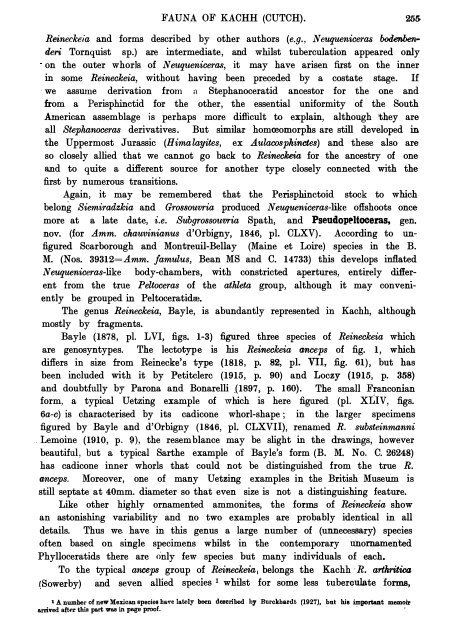ialontolngia ndita,
ialontolngia ndita,
ialontolngia ndita,
Create successful ePaper yourself
Turn your PDF publications into a flip-book with our unique Google optimized e-Paper software.
FAUNA OF KACHH (CUTCH).<br />
255-<br />
Reineckeia and forms described by other authors (e.g., Ne-uqueniceras bodenbenderi<br />
Tornquist sp.) are intermediate, and whilst tuberculation appeared only<br />
on the outer whorls of Ne-uq-ueniceras, it may have arisen first on the inner<br />
in some Reineckeia, without having been preceded by a costate stage. If<br />
· we assume derivation from a Stephanoceratid ancestor for the one and<br />
from a Perisphinctid for the other, the essential uniformity of the South<br />
American assemblage is perhaps more difficult to explain, although they are<br />
all Stephanoceras derivatives. But similar homreomorphs are still developed in<br />
the Uppermost Jurassic (Himalayites, ex Aulacosphinctes) and these also are<br />
so closely allied that we cannot go back to Reineckeia for the ancestry of one<br />
and to quite a different source for another type closely connected with the<br />
first by numerous transitions.<br />
Again, it may be remembered that the Perisphinctoid stock to which<br />
belong Siemiradzkia and Grossouvria produced N euq-ueniceras-like offshoots once<br />
more at a late date, i.e. Subgrosso-uvria Spath, and PseudopPltoceras, gen.<br />
nov. (for Amm. chauvinianus d'Orbigny, 1846, pl. · CLXV). According to unfigured<br />
Scarborough and Montreuil-Bellay (Maine et Loire) species in the B.<br />
M. (Nos. 39312=Amm. famulus, Bean MS and C. 14733) this develops inflated<br />
N euqueniceras-like body-chambers, with constricted apertures, entirely different<br />
from the true Peltoceras of the athleta group, although it may convemently<br />
be grouped in Peltoceratidre.<br />
The genus Reineckeia, Bayle, is abundantly represented in Kachh, although<br />
mostly by fragments.<br />
Bayle (1878, pl. LVI, figs. 1-3) figured three species of Reineckeia which<br />
are genosyntypes. The lectotype is his Reineckeia anceps of fig. 1, which<br />
differs in size from Reinecke's type (1818, p. 82, pl. VII, fig. 61), but has<br />
been included with it by Petitclerc (1915, p. 90) and Loczy (1915, p. 358)<br />
and doubtfully by Parona and Bonarelli _(1897, p. 160). The small Franconian<br />
form, a typical Uetzing example of which is here figured (pl. XLIV, figs.<br />
6a-c) is characterised by its cadicone whorl-shape ; in the larger specimens<br />
figured by Bayle and d'Orbigny (1846, pl. CLXVII), renamed R. substeinmanni<br />
. Lemoine (1910, p. ), the resemblance may be slight in the drawings, however<br />
beautiful, but a typical Sarthe example of Bayle's form (B. M. No. C. 26248)<br />
has cadicone inner whorls that could not be distinguished from the true R.<br />
anceps. Moreover, one of many Uetzing examples in the British Museuin is<br />
still septate at 40mm. diameter so that even size is not a distinguishing feature.<br />
Like other highly ornamented ammonites, the forms of Reineckeia show<br />
an astonishing variability and no two examples are probably identical in all<br />
details. Thus we. have in this genus a large number of (unnecessary) species<br />
often based on single specimens whilst in the contemporary unornamented<br />
Phylloceratids there are only few species but many individuals of each.<br />
To the typical anceps group of Reineckeia 1 belongs the Kachh · R. arlhritica<br />
(Sowerby) and seven allied species 1 whilst for some less tuberculate forms,<br />
1 A number of new Mexica.n species ha'\"e lately been described by Burckhardt (1927), but his important memoir<br />
arrived aft.flr this part was in page proof.<br />
· ·<br />
-
















